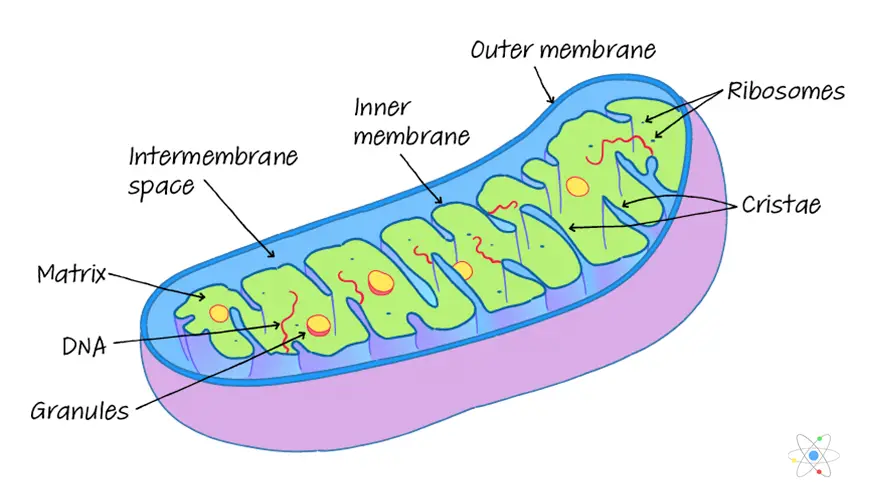The primary function of mitochondria in animal cells is to generate energy in the form of ATP through cellular respiration, but they are also involved in a range of other processes, including cell signaling, lipid metabolism, hormone synthesis, and maintenance of cell homeostasis.
Definition of Mitochondria
Mitochondria are organelles found in most animal cells, and their main function is to produce energy in the form of ATP (adenosine triphosphate) through a process called cellular respiration. They are sometimes referred to as the “powerhouses” of the cell. Mitochondria are fascinating organelles that play a critical role in the functioning of animal cells. Understanding their functions is crucial in order to gain insight into cellular energy metabolism, signaling, and overall homeostasis.
Why Understanding Mitochondria Is Important
Understanding the functions and mechanisms of mitochondria is crucial for several reasons.
Firstly, mitochondria are responsible for producing the majority of the ATP that cells use as an energy source. This energy is critical for a wide range of cellular processes, including muscle contraction, metabolism, and gene expression. Any dysfunction or damage to mitochondria can significantly impact these processes, leading to various diseases and disorders.
Secondly, mitochondria play a crucial role in regulating cell signaling and gene expression. They are involved in the regulation of calcium levels within the cell, which is important for many cellular processes, including muscle contraction and neuronal signaling. Additionally, mitochondria can produce reactive oxygen species (ROS), which can act as signaling molecules to regulate gene expression and other cellular processes. Therefore, understanding the role of mitochondria in these signaling pathways is essential for developing treatments for various diseases.
Thirdly, mitochondria are involved in a range of metabolic processes, including lipid metabolism and hormone synthesis. Disruptions to these processes can lead to various disorders such as diabetes and obesity. Understanding how mitochondria regulate these processes can lead to the development of new treatments and therapies for these conditions.
The Function of Mitochondria in an Animal Cell

A. Produces Energy
As previously mentioned, mitochondria are primarily responsible for generating ATP through cellular respiration. This process occurs in several stages, with different enzymes and pathways involved. The first stage, glycolysis, occurs in the cytoplasm outside of the mitochondria, while the subsequent stages occur within the mitochondria. In addition to generating ATP, this process also produces carbon dioxide and water as byproducts.
B. Involved in Cell Signaling
Mitochondria are also involved in various signaling pathways within the cell. For example, they can release calcium ions into the cytosol, which can activate signaling cascades that regulate cell growth and apoptosis (programmed cell death). Mitochondria can also produce reactive oxygen species (ROS), which can act as signaling molecules to regulate gene expression and other cellular processes.
C. Metabolizes Lipids
Mitochondria also play a role in lipid metabolism. They are involved in the breakdown of fatty acids through beta-oxidation, which generates acetyl-CoA that can be used in cellular respiration. Additionally, mitochondria are involved in the synthesis of certain lipids, such as cardiolipin, which is a component of the mitochondrial inner membrane.
D. Regulates Calcium
As previously mentioned, mitochondria can regulate calcium levels within the cell. They can take up and release calcium ions, and their activity is regulated by various calcium channels and transporters. This regulation is critical for maintaining proper calcium signaling within the cell, which is important for many cellular processes, including muscle contraction and neuronal signaling.
E. Synthesizes Hormones
Mitochondria are involved in the synthesis of certain hormones, such as steroid hormones. These hormones are synthesized from cholesterol, which is converted to pregnenolone within the mitochondria. Pregnenolone can then be further converted into various steroid hormones, such as testosterone and estrogen.
F. Maintains Cell Homeostasis
Finally, mitochondria play a crucial role in maintaining cellular homeostasis. They can sense changes in cellular energy status and respond by regulating mitochondrial fission and fusion, mitophagy (the selective degradation of damaged mitochondria), and other processes that help to maintain proper mitochondrial function.
FAQs
What is the primary function of mitochondria in an animal cell?
The primary function of mitochondria is to produce ATP, which is the main source of energy for the cell.
What is cellular respiration, and where does it occur in the cell?
Cellular respiration is the process by which cells produce ATP. It occurs in the mitochondria.
How does mitochondrial dysfunction occur?
Mitochondrial dysfunction can occur due to genetic mutations, exposure to toxins, and aging.
What are the consequences of mitochondrial dysfunction?
Mitochondrial dysfunction can lead to a range of health problems, including neurodegenerative diseases, cardiovascular disease, and diabetes.
Why are mitochondria important in maintaining cell health?
Mitochondria are responsible for the production of energy, which is needed for cellular processes such as cell division, growth, and repair. They also play a role in regulating cell death, or apoptosis, and are involved in calcium signaling within the cell.
How do mitochondria produce ATP?
ATP is produced through a series of chemical reactions that take place in the mitochondria. The process involves the breakdown of glucose or other molecules into pyruvate, which is then further broken down into acetyl-CoA. Acetyl-CoA then enters the citric acid cycle, which produces electrons that are transferred to the electron transport chain. The electron transport chain generates a proton gradient across the inner membrane of the mitochondria, which drives the production of ATP through the process of oxidative phosphorylation.
Can mitochondrial dysfunction be treated?
Currently, there is no cure for mitochondrial dysfunction, but treatments can be used to manage symptoms and improve quality of life.
Can mitochondrial dysfunction be inherited?
Yes, mitochondrial dysfunction can be inherited through mutations in mitochondrial DNA, which is passed down from the mother to her offspring.
Are mitochondria found in all animal cells?
Yes, mitochondria are found in most eukaryotic cells, including animal cells.
Can mitochondria regenerate?
Yes, mitochondria can replicate and divide on their own, allowing for regeneration and maintenance of cellular function. However, this process can be affected by mitochondrial dysfunction.
Conclusion
In conclusion, mitochondria are essential organelles that perform a multitude of functions within animal cells. Their primary role in energy production is critical for maintaining cellular function, but they are also involved in a range of other processes that contribute to overall cell homeostasis. Understanding the functions of mitochondria is crucial for advancing our knowledge of cellular biology and developing new therapies for a range of diseases. Further research in this field is sure to yield new insights into the complex workings of these fascinating organelles.
References:
https://pubmed.ncbi.nlm.nih.gov/24195633/
https://www.britannica.com/science/mitochondrion

I’m Christopher Benjamin, a dedicated Animal Nutritionist at Ethos Veterinary Health with a Bachelor of Science in Animal Science from Michigan State University. My lifelong passion for animals led me to establish AnimalsData.Com. Here, I share expert advice, educational resources, and inspiring stories to empower fellow pet lovers worldwide. Join our community as we celebrate the beauty and diversity of our beloved animal companions!
